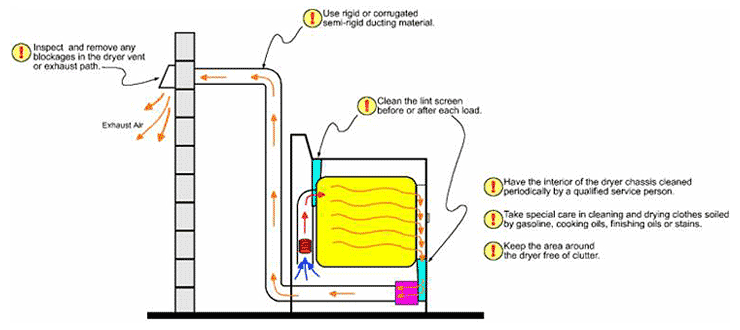Facts
Did you know?
- According to the 1997 estimates by the U.S. Consumer Product Safety Commission there were 15,600 fires, 20 deaths, 370 injuries and $75.4 million in property damage all attributed to dryer fires.
- From 1987-1997 dryer fires were up 10%, injuries were up more than 100% and property damage was up 46%
- According to the U.S. Fire Administration, 80% of clothes dryer fires occur in residential buildings.
- "Failure to clean" is the leading cause of dryer fires.
- The average U.S. home can save almost 30% in clothes drying costs by cleaning and maintaining dryer vent lines.
Let Us Help You Prevent Dryer Fires!
- Professional, trained service techs that are on-time, courteous and thorough.
- Regular professional cleaning improves efficiency and safety of your dryer.
- Clean the filter screen before or after each load.
- Clean the dryer vent to the outside. Contact a professional to be sure this is done correctly and completely.
- Clean the motor area! Heat buildup can ignite dust and lint built up in this area.
- If you notice poor drying conditions or excessive lint outside under the vent contact a professional to inspect your dryer!
How we can help:
What you should do:

Consumer Products Safety Commission
Overheated Clothes Dryers Can Cause Fires
CPSC Document #5022 - Updated June 2003
The U.S. Consumer Product Safety Commission estimates that in 1998, clothes dryers were associated with 15,600 fires, which resulted in 20 deaths and 370 injuries. Fires can occur when lint builds up in the dryer or in the exhaust duct. Lint can block the flow of air, cause excessive heat build-up, and result in a fire in some dryers.
To help prevent fires:
- Clean the lint screen/filter before or after drying each load of clothes. If clothing is still damp at the end of a typical drying cycle or drying requires longer times than normal, this may be a sign that the lint screen or exhaust duct is blocked.
- Clean the dryer vent and exhaust duct periodically. Check the outside dryer vent while the dryer is operating to make sure exhaust air is escaping. If it is not, the vent or the exhaust duct may be blocked. To remove a blockage in the exhaust path, it may be necessary to disconnect the exhaust duct from the dryer. Remember to reconnect the ducting to the dryer and outside vent before using the dryer again.
- Clean behind the dryer, where lint can build up. Have a qualified service person clean the interior of the dryer chassis periodically to minimize the amount of lint accumulation. Keep the area around the dryer clean and free of clutter.
- Replace plastic or foil, accordion-type ducting material with rigid or corrugated semi-rigid metal duct. Most manufacturers specify the use of a rigid or corrugated semi-rigid metal duct, which provides maximum airflow. The flexible plastic or foil type duct can more easily trap lint and is more susceptible to kinks or crushing, which can greatly reduce the airflow.
- Take special care when drying clothes that have been soiled with volatile chemicals such as gasoline, cooking oils, cleaning agents, or finishing oils and stains. If possible, wash the clothing more than once to minimize the amount of volatile chemicals on the clothes and, preferably, hang clothes to dry. If using a dryer, use the lowest heat setting and a drying cycle that has a cool-down period at the end of the cycle. To prevent clothes from igniting after drying, do not leave the dried clothes in the dryer or piled in a laundry basket.
Source: Consumer Product Safety Alert
